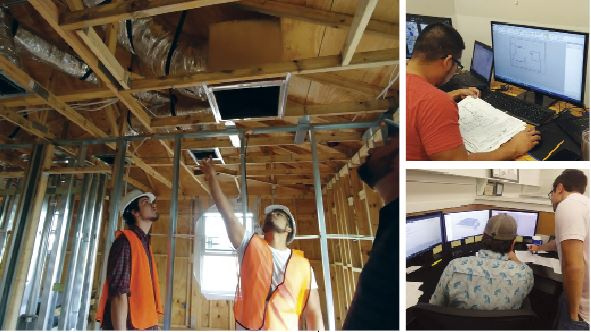Thinking Outside the Building Plans to Train Designers
Thinking Outside the Building Plans to Train Designers
“Creative problem solving is key, just like when designing trusses, the answer isn’t always so clear. You have to evaluate the situation and come up with a solution to accomplish the goal.”
That was part of Jason Smith and Travis White’s instructions to their designers at A-1 Roof Trusses in Fort Pierce, Florida. Jason, a design trainer, and Travis, the company’s design manager, are providing opportunities to help their team stay sharp, think on their feet, and be prepared to handle design-related situations as they arise.
The two recently challenged their team to create the most difficult process to design and display a truss using plastic bottles, old toys, and other miscellaneous items. The final creations, commonly known as “Rube Goldberg machines,” helped the designers offer their different perspectives on how to complete the challenge. A-1 designers have also been challenged to design and build bridges using Popsicle sticks.

When it comes to the component manufacturing industry, Travis says the current software and other tools available make it possible for designers to “pretty much handle anything the architects and engineers dream up.”
Unless a design just absolutely won’t work. That’s where a designer’s ability to think on their feet is important.
Both Travis and Jason describe scenarios where building plans are inaccurate or conflict with another piece of the plan, whether it’s a difficult framing set up that is nearly impossible to girder, out of date building plans, or dimensions that don’t add up.
“One of the most difficult things to teach is whether the new designer is wrong or the drawings are wrong,” says Jason. “They second guess themselves.”
To help combat their second-guessing, Jason says the company uses roleplaying to equip designers with tips for effective communication with architects, engineers, and other customers at the beginning of the project. Programs such as GoToMeeting are highly encouraged, “where designers can ask their questions and explain their concerns more easily by showing than speaking over the phone,” says Jason.
Like many design managers, the two also give their new recruits purposefully inaccurate designs to see how they handle working through the issues.
Aside from handling difficult building plans, Jason says handling difficult customers is the other critical piece that designers need to be ready to handle at a moment’s notice.
“Phone calls are our biggest distraction,” he says. “As designers, we are used to doing work at our computer, so external phone calls shake us up a little.”
In these situations, he says the best training a design manager can offer is to ensure their designers stay calm, document all of the information, and feel comfortable letting the customer know if they do not have the answer but will follow-up with them with the right information.
“It’s important to collect your thoughts, do the research, and figure out what’s going on to solve this for everyone involved,” Jason says. “Taking that step back and asking for that moment to sort everything out, and ask questions, can make a world of difference.”
The final piece that Travis emphasizes is their training of not just their new designers but of their experienced designers as well. Both Jason and Travis will tell you that it’s just as important to train veteran designers on best strategies for mentoring new or young team members.
“When a new designer asks an experienced designer for help, we want to make sure they guide them through the process,” Travis says. “It’s important mentors show the different tools we have at our disposal and how to efficiently use those tools and help them understand the general mental processes at arriving at an answer.”

